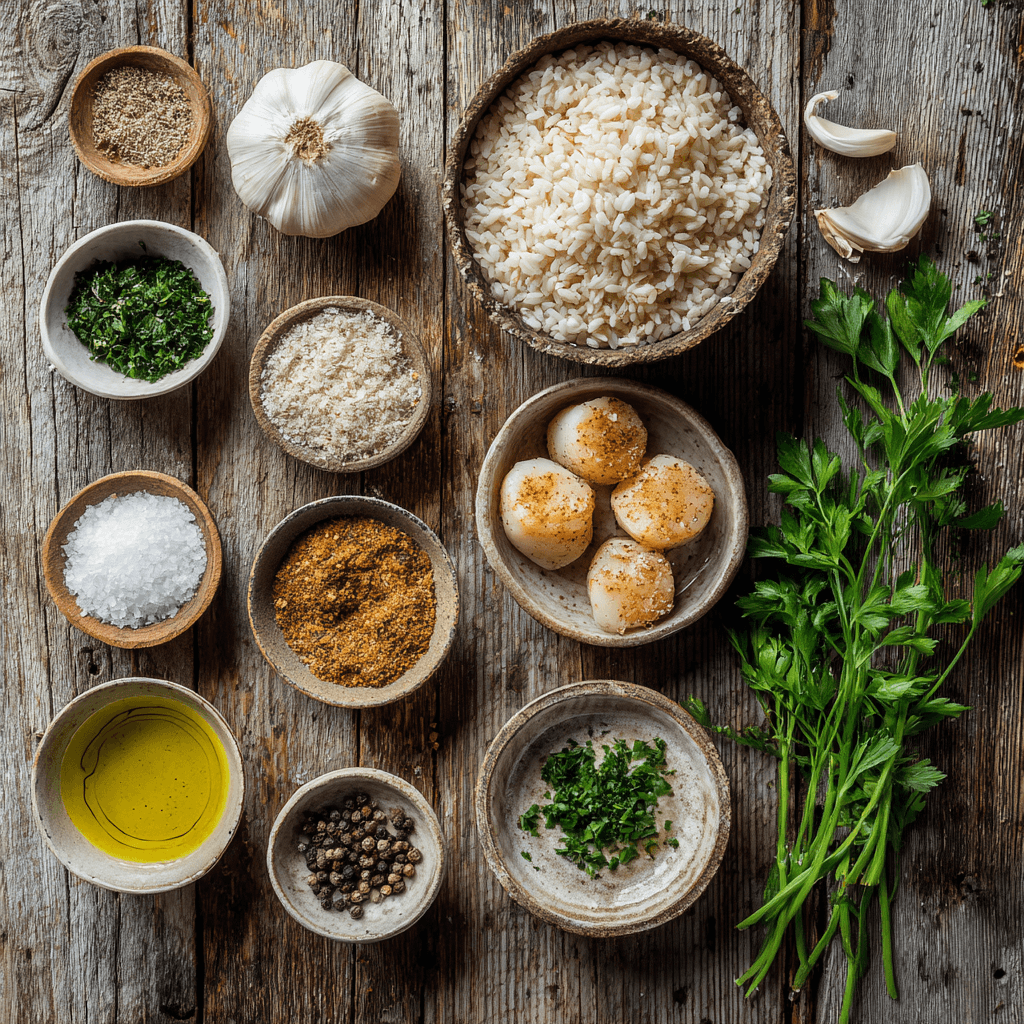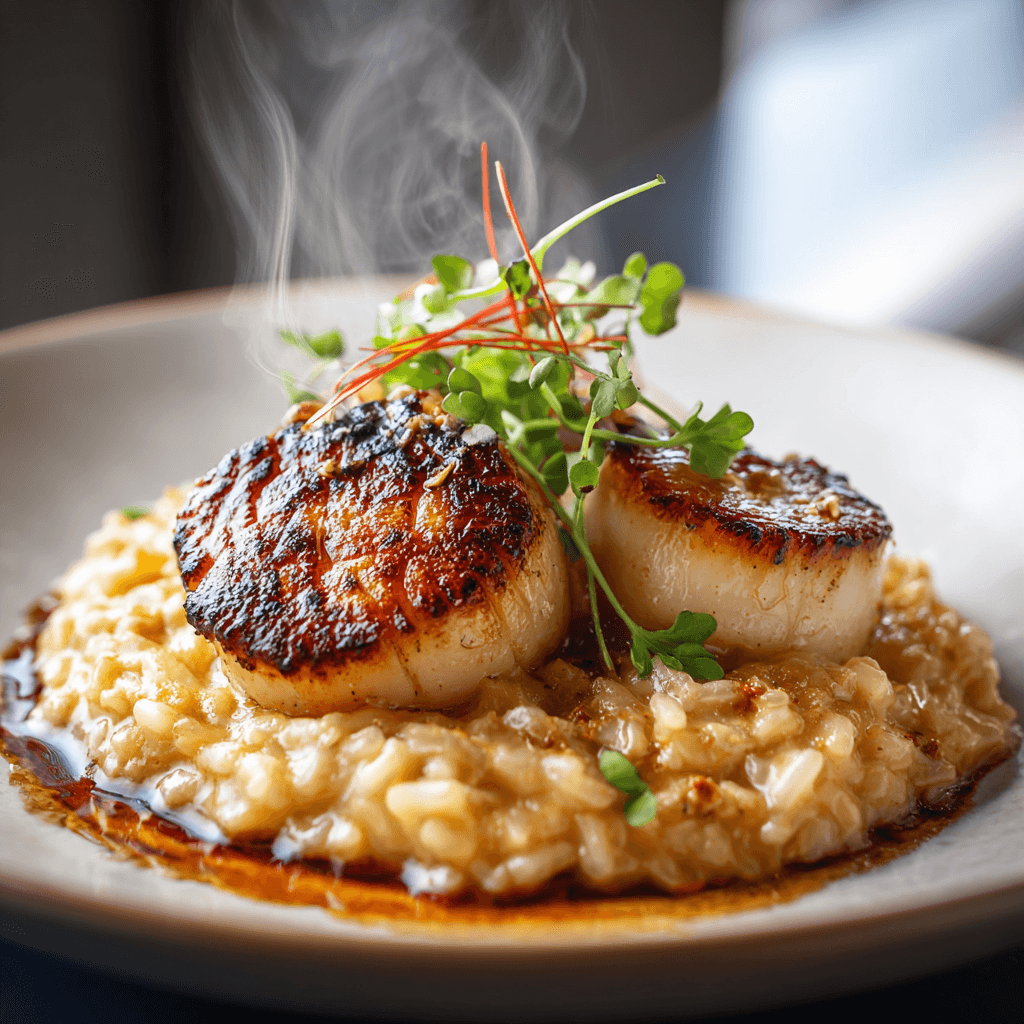Table of Contents
Gordon Ramsay Scallop Risotto represents the pinnacle of sophisticated comfort food – a dish that transforms humble rice into something extraordinary through precise technique and timing. After responding to countless kitchen fires during my firefighting days, I learned that the most dangerous cooking situations often stem from rushing complex dishes like this one. The FDA emphasizes proper seafood handling for dishes combining delicate proteins with starches, making this pan-seared scallops technique even more critical to master safely.
Why This Gordon Ramsay Scallop Risotto Recipe Works (And Where Most Go Wrong)
The genius behind Gordon Ramsay Scallop Risotto lies in understanding three fundamental principles that separate restaurant-quality results from mushy disappointments. First, the rice selection and toasting process creates the foundation – Arborio rice contains the perfect amount of amylose starch that releases gradually when stirred, creating that signature creaminess without becoming gluey.
Most home cooks make the critical error of adding cold stock directly to the rice, which shocks the grains and prevents proper starch release. Gordon’s method involves keeping the stock at a gentle simmer throughout the cooking process, allowing each addition to be absorbed completely before adding more liquid.
The second principle involves timing the scallops perfectly. Too many people attempt to cook both components simultaneously, leading to overcooked scallops or undercooked rice. The Gordon Ramsay Scallop Risotto method requires finishing the risotto base to 80% completion before even touching the scallops, ensuring both elements reach their peak simultaneously.
Ingredients That Actually Matter for Gordon Ramsay Scallop Risotto

Quality ingredients make the difference between good and extraordinary Gordon Ramsay Scallop Risotto. Arborio rice from Northern Italy contains the highest starch content, creating that essential creamy texture without breaking down into mush. When shopping, look for grains that appear almost translucent with a white pearl center – this indicates proper aging and starch development.
For scallops, size matters significantly. U-10 scallops (meaning 10 or fewer per pound) provide the ideal surface area for proper searing while maintaining a tender interior. Avoid wet-packed scallops, which contain sodium tripolyphosphate that prevents proper browning and adds an artificial taste. Dry-packed scallops should smell like ocean breeze, never fishy.
The stock serves as the flavor foundation – homemade seafood or chicken stock provides richness that boxed alternatives simply cannot match. However, if using store-bought, choose low-sodium versions to control the final seasoning. Fresh Parmigiano-Reggiano aged at least 24 months contributes nutty depth, while younger cheeses turn stringy when melted. White wine must be dry – Pinot Grigio or Sauvignon Blanc work perfectly, but avoid anything you wouldn’t drink, as cooking concentrates flavors dramatically.
Step-by-Step Instructions for Gordon Ramsay Scallop Risotto
Preparing the Foundation
Begin by bringing 6 cups of seafood or chicken stock to a gentle simmer in a separate saucepan – maintain this temperature throughout cooking. Heat 2 tablespoons olive oil in a heavy-bottomed pan over medium heat. Add 1 finely diced shallot and cook for 2 minutes until translucent but not browned. Never let the shallot color, as this creates bitter undertones that will ruin the entire dish.
Building the Risotto Base
Add 1½ cups Arborio rice to the pan, stirring constantly for 2-3 minutes until the grains become translucent around the edges with white centers remaining. This toasting process is crucial for proper texture. Pour in ½ cup dry white wine and stir until completely absorbed – you’ll hear the sizzling stop when the liquid evaporates.
Begin adding the warm stock one ladle at a time (approximately ¾ cup), stirring constantly in a consistent motion. Wait until each addition is almost completely absorbed before adding the next ladle. This process takes patience – rushing leads to uneven cooking and poor texture. Continue for approximately 18-20 minutes until the rice is creamy but still maintains slight firmness when bitten.
Preparing the Scallops
While the risotto reaches 80% completion, remove 1 pound large sea scallops from refrigeration. Pat each scallop completely dry with paper towels – any moisture prevents proper searing and creates dangerous oil spattering. Remove the side muscle if still attached and season both sides with salt and white pepper.
Heat a stainless steel or cast iron pan over high heat until it begins smoking slightly. Add 1 tablespoon neutral oil with high smoke point. Never use olive oil for searing – it burns at high temperatures and creates acrid flavors. Place scallops in the pan without crowding, ensuring each has space around it. Sear for 2-3 minutes without moving until a golden crust forms, then flip and cook for another 1-2 minutes.
Final Assembly
Remove the risotto from heat and immediately stir in 3 tablespoons cold butter and ½ cup grated Parmigiano-Reggiano. This mantecatura technique creates the final silky texture that defines perfect Gordon Ramsay Scallop Risotto. Taste and adjust seasoning with salt, white pepper, and lemon juice. The consistency should flow like lava when stirred but hold its shape when plated. Serve immediately with the seared scallops arranged on top, finishing with additional cheese and fresh herbs like chive oil or parsley.
Pro-Tips That Change the Game
- Keep a separate ladle specifically for the stock – switching between hot stock and risotto prevents temperature shock to the rice grains
- Test doneness by tasting individual rice grains, not just the overall texture – each grain should be creamy outside with a slight firmness in the center
- Add a splash of heavy cream during the mantecatura stage for extra richness, but never more than 2 tablespoons or it masks the rice’s natural starch
- Reserve some pasta cooking liquid when making other dishes – it adds starch and salinity that enhances risotto texture when stock runs low
- Warm your serving plates in a 200°F oven – Gordon Ramsay Scallop Risotto cools rapidly and congeals on cold dishware
- Save scallop searing for absolute last moment – they continue cooking from residual heat and become rubbery if held too long
Storage & Leftovers for Gordon Ramsay Scallop Risotto
Gordon Ramsay Scallop Risotto presents unique storage challenges due to its delicate components. The risotto base can be refrigerated for up to 2 days in an airtight container, but the texture will firm considerably as the starches set. When reheating, add warm stock gradually while stirring gently over low heat – never use a microwave, which creates uneven heating and rubber-like textures.
Cooked scallops should be stored separately and consumed within 24 hours for optimal safety and quality. The FDA recommends storing seafood at temperatures below 40°F and reheating to 165°F internal temperature. However, reheating scallops typically results in overcooked, tough protein – consider using leftover scallops cold in salads or grain bowls instead. For best results, prepare Gordon Ramsay Scallop Risotto fresh and plan portions carefully to minimize leftovers.

Gordon Ramsay Scallop Risotto
Ingredients
Equipment
Method
- 1️⃣ Bring 6 cups of seafood or chicken stock to a gentle simmer in a separate saucepan and maintain this temperature throughout cooking.
- 2️⃣ Heat 2 tablespoons olive oil in a heavy-bottomed pan over medium heat. Add finely diced shallot and cook for 2 minutes until translucent but not browned.
- 3️⃣ Add 1½ cups Arborio rice to the pan, stirring constantly for 2-3 minutes until grains become translucent around edges with white centers remaining.
- 4️⃣ Pour in ½ cup dry white wine and stir until completely absorbed – you’ll hear the sizzling stop when liquid evaporates.
- 5️⃣ Begin adding warm stock one ladle at a time (¾ cup), stirring constantly. Wait until each addition is almost completely absorbed before adding next ladle. Continue for 18-20 minutes until rice is creamy but maintains slight firmness.
- 6️⃣ When risotto reaches 80% completion, pat 1 pound large sea scallops completely dry with paper towels. Remove side muscle if attached and season both sides with salt and white pepper.
- 7️⃣ Heat stainless steel or cast iron pan over high heat until smoking slightly. Add 1 tablespoon neutral oil. Place scallops without crowding, sear 2-3 minutes without moving until golden crust forms, then flip and cook 1-2 minutes more.
- 8️⃣ Remove risotto from heat and immediately stir in 3 tablespoons cold butter and ½ cup grated Parmigiano-Reggiano using mantecatura technique.
- 9️⃣ Taste and adjust seasoning with salt, white pepper, and lemon juice. Consistency should flow like lava when stirred but hold shape when plated.
- 🔟 Serve immediately with seared scallops arranged on top, finishing with additional cheese and fresh herbs.
Nutrition
Notes
Tried this recipe?
Let us know how it was!Frequently Asked Questions About Gordon Ramsay Scallop Risotto
What makes Gordon Ramsay’s risotto special?
Gordon Ramsay Scallop Risotto stands apart through his emphasis on temperature control and timing precision. His technique involves maintaining stock at exactly the right temperature, incorporating butter at the precise moment for mantecatura, and coordinating the scallop searing to finish simultaneously with the rice. The result is restaurant-quality texture and flavor that most home versions cannot achieve.
What are some good sides for scallop risotto?
Gordon Ramsay Scallop Risotto serves beautifully as a complete main course, but light accompaniments enhance the experience. A simple arugula salad with lemon vinaigrette cuts through the richness, while roasted asparagus adds textural contrast. Cucumber salad provides refreshing acidity, and crusty bread helps capture every creamy bite. Avoid heavy sides that compete with the delicate seafood flavors.
How does Gordon Ramsay prepare scallops?
Gordon’s scallop preparation for Gordon Ramsay Scallop Risotto focuses on achieving the perfect sear. He emphasizes completely drying the scallops, using high heat with neutral oil, and never moving them during the initial searing phase. The key is creating a golden caramelized crust while maintaining a tender, slightly translucent center. Proper seasoning timing and pan temperature create the signature restaurant-quality result.
How long does scallop risotto last?
Gordon Ramsay Scallop Risotto maintains peak quality for immediate consumption only. The risotto base can be refrigerated for 2 days maximum, while cooked scallops should be consumed within 24 hours for safety. The dish’s delicate nature means texture and flavor deteriorate rapidly. Freezing is not recommended as both the rice and seafood suffer significant quality loss during thawing and reheating processes.
This Gordon Ramsay Scallop Risotto recipe transforms your kitchen into a professional restaurant, creating memories through exceptional food. Master these techniques with patience and attention to detail, and you’ll discover why this dish represents the pinnacle of home cooking achievement.
Stay safe,
Jack Sullivan


